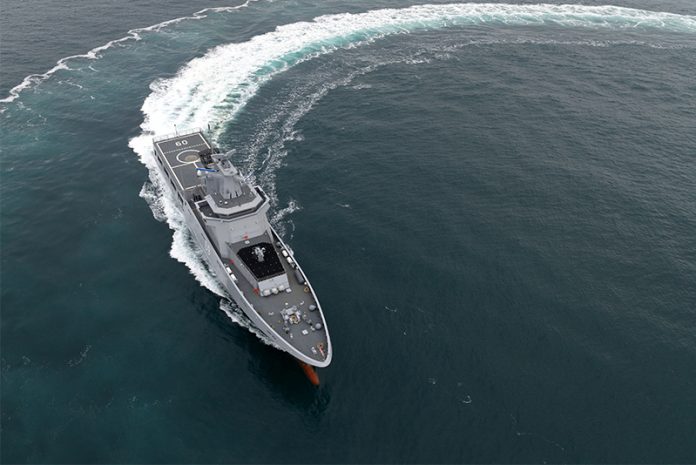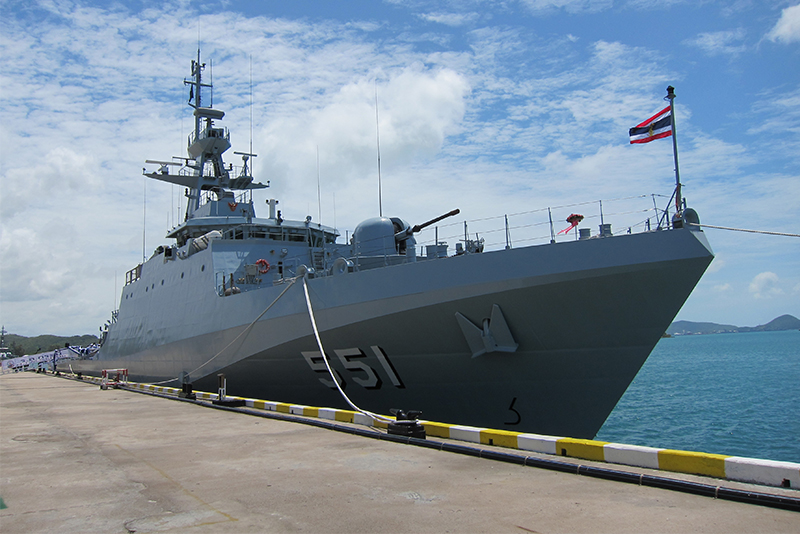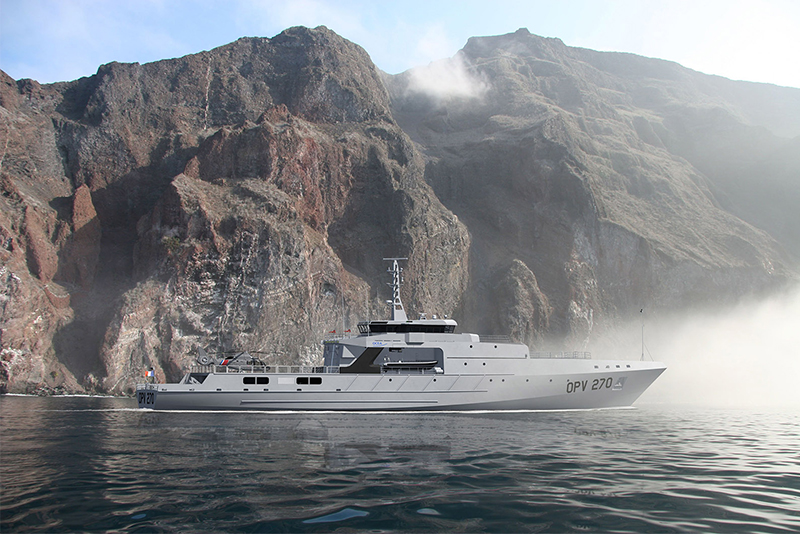
Asian-Pacific navies traditionally operate traditional warships leading the Coast Guards to benefit from very capable Offshore Patrol Vessels (OPV).
Offshore Patrol Vessels (OPVs) have gained in stature in the Indo-Pacific region as maritime security has come sharply into focus for governments. The economic and political value of Economic Exclusive Zones (EEZs) has been realised by leaders due to regulations under the United Nations Convention of the Law of the Sea (UNCLOS) and countries in the region are belatedly prioritising investment in new ships of this kind.
Naval vs Coast Guard
OPVs are operated by a mix of naval and coastguard forces although this depends on each country’s maritime security structure. Dr Collin Koh Swee Lean, research fellow at the S. Rajaratnam School of International Studies in Singapore told AMR that there are two main issues: “The biggest issue has always been funding and this is related to the second biggest: inter-service problems. This is often a barrier to establishing a maritime security architecture, which has an impact downstream about how they allocate resources more optimally.” This is especially the case in the sub-region of South East Asia where rival naval and coastguard services compete for limited funding.
Another trend in the region according to Dr. Lean is that the line between OPV and corvettes is often blurred. “Shipbuilders tell clients that if you buy a full-size OPVs then the heaviest armament can be a gun with helicopters, but these can be scaled up to become a light frigate,” he said. This is notable in a few OPV acquisition programmes where designs are flexible for the addition of advanced sensors and weapons if required.
Royal Australian Navy (RAN)
The Royal Australian Navy (RAN) is undertaking one of the largest new OPV programmes in the Asia-Pacific region under its Project SEA 1180 Phase 1 for 12 new ships. Known as the Arafura-class, these are being built to the OPV80 design by German shipbuilder Lürssen under a contract worth $2.5 billion (A$3.6 billion). The Arafura-class design is a variant of the baseline model OPV that Lürssen provided to the Royal Brunei Navy with the Darussalam-class of four ships that entered service from 2011-14.
Lürssen was selected in November 2017 and the company has partnered with Australian shipyards for construction. The first two OPVs will be built at ASC Shipbuilding in Adelaide, South Australia, with the remaining 10 by Civmec in Henderson, Western Australia. Construction of the 1,640 tonne OPVs started at ASC in 2018 and the RAN announced that the keel was laid for the first ship, Arafura, in March 2019. The ship is expected to enter service in 2022.
The RAN wants the OPVs to become multipurpose ships and will host high-end sensors, with Saab Australia’s 9LV Combat Management System and EOS 500 fire control director. The ships will also be equipped with special mission packages to support maritime tactical unmanned aerial systems and mine countermeasures capabilities.
Vietnam Eyes Larger OPVs
Dutch shipbuilder Damen Schelde Naval Shipbuilding (DSNS) has also been successful in the region and its 9014 OPV design was selected by the Vietnam Coastguard (renamed the DN2000) for a class of new 2,400 tonne ships being built at the state-run Song Thu Group in Danang.
The first ship was launched in November 2015 as a multipurpose ship designated CBS 8005 but it is unclear if the vessel has entered service or if the construction of a second ship has progressed. Vietnam has a requirement for OPVs to counter the encroachment of Chinese vessels into the South China Sea and Dr. Lean said Vietnam is now looking at the larger 4,000 tonne DN4000 design from Song Thu to meet a requirement for up to six vessels to serve both the Coast Guard and fisheries patrol.
“The Vietnamese Parliament has actually passed the Vietnam Coast Guard law that clearly defines the roles and responsibilities of the Coast Guard vis-à-vis the other services like the Navy, that will justify future procurement,” he explained.
“The Coast Guard comes under the Ministry of Defence anyway, so getting funding is easier compared to other SE Asian counterparts as the Navy wants to focus more on warfighting capabilities,” he added.

Malaysian OPV programme
The Malaysian Maritime Enforcement Agency (MMEA) has also opted for a Damen design, the OPV1800. Three ships are being built by TH Heavy Engineering (THHE) and Destini in a Joint Venture arrangement at the Destini-THHE Pulah Indiah shipyards in Port Klang.
A spokesperson from DSNS confirmed to AMR: “Three Damen OPVs 1800 are under construction at Destini Shipbuilding & Engineering for the MMEA in Malaysia with an expected delivery time of 2020.”
The project is slated to cost $160 million for all three 83 metre long ships but DSNS was unable to confirm what stage of construction the ships had reached therefore it is unclear if the mid-2020 delivery date can be met. Dr. Lean said that with only $12 billion (RM50 billion) funding for defence the next 10 years it will not allow them to buy many. “We won’t see the MMEA get any more ships beyond the existing programmes under construction,” he said.
Pakistan Navy
Meanwhile the Pakistan Navy is set to receive two new 2,300 tonne OPVs from DSNS, which are under construction at the company’s shipyard in Galati, Romania. The first ship was launched in May 2019 and is expected to enter service later this year. Steel cutting started on the second vessel in August 2018 and is due to enter service by mid-2020.
The Pakistan Navy has referred to the ships as multirole corvettes but Dr. Lean said that they are “much closer to an OPV than anything else” and are based on the DSNS 90m long OPV2400 design.
Indonesian Coast Guard vs the Indonesian Navy
The Indonesian Navy (TNI-AL) has been moving towards operating mainly combat vessels and high-end frigates and this leaves the Indonesian Coast Guard (BAKAMLA) to undertake the constabulary role. It has already taken delivery of a large new 110m 2,700 tonne OPV named KN Tanjung Datu in January 2018 from indigenous shipbuilder PT Malindo, built to its own design.
Dr. Lean said this OPV looks impressive and “is designed to counter the Chinese in terms of size and length and in terms of tonnage will be a match for the frontline OPVs that the Chinese Coast Guard has been fielding in the Natuna Sea area.”

Under its medium-term development plan, BAKAMLA had an ambition to build 30 ships by 2019 including four 110m OPVs and as many as 10 of the 80m vessels, much of which remains to be achieved. It is not just funding but inter-service rivalry that is an issue.
“The TNI-AL does not like that BAKAMLA is going to get more funding and will do what it can to prevent it from getting the necessary resources, so even if the Navy does not get OPVs it will make sure BAKAMLA does not get too many of them either,” stated Dr. Lean. “The Navy would rather send frigates to do mere fisheries patrol.”
In December 2018 another Indonesian shipyard, PT Citra, announced that three new 80m OPVs were launched by the company to a Terafulk design. Built for an estimated $42 million the ships are named Pulau Nipah (8001), Marore Island (8002) and Dana Island (8003). It is not clear when the OPVs will enter service and unconfirmed images online seem to show the second vessel damaged after a broken lock flooded the dry dock area where it was fitting out
Royal Thai Navy (RTN)
In Thailand local shipbuilder Bangkok Dock in Sattahip completed construction of its first 90m Krabi-class OPV in August 2013. It was built to the 90m OPV design from BAE Systems under a technology transfer agreement worth approximately $79.2 million.
Construction of a second ship started in 2016 for an estimated $155 million and is expected to be delivered during 2019. The company told AMR that it “provided in-country assistance for a two-year period with the initial design support to integrate the 76mm main gun and, on the second OPV, to add Boeing Harpoon anti-ship missiles.”

Dr. Lean believes there is space for at least four Harpoon anti-ship missiles and although integration is a challenge “it is not a straightforward or easy process,” he added that it “should not be a problem”, but the issue is whether the RTN will “cough up the money to do that.” The RTN has a requirement for a total of five OPVs but it is unlikely to secure funding for more ships in the short term.
Philippines Coast Guard
The Philippines has been taking delivery of a set of five small patrol ships from French shipbuilder OCEA for the Philippines Coast Guard under a $103 million contract, but one is expected to be an 84m OPV built to the yard’s OPV270 design.

The Philippines Coast Guard has announced that the OPV is under construction and will be named BRP Gabriela Silang, with delivery expected in August 2019. A second is under consideration.
Meanwhile Defence Minister Delfin Lorenzana has indicated his preference for Austal to participate in a new OPV programme for up to six ships to be built in-country for the Philippine Navy. Austal is offering its 81.7m OPV design.
Indian OPVs Dogged by Delays
India has large OPV programmes underway but after steel is cut there seem to be issues getting them into service. Goa Shipyard Ltd (GSL) has already completed the delivery of six Samarth-class OPVs in 2017 and a contract for a further five could be expected.
Meanwhile Larsen and Toubro (L&T) was awarded a contract to build seven OPVs for the Indian Coastguard in March 2015 and although it launched the first vessel in October 2017, it is not clear what stage of construction this ship has reached or the status of follow-on ships.
Elsewhere, Reliance Naval and Engineering Ltd (RNEL) – formerly Pipavav Offshore and Engineering – is building five new 1,500 tonne Shachi-class Naval OPVs (NOPVs) under Project 21 (P-21). The first two (Shachi and Shruti) are under construction and were launched in July 2017 with an expected delivery date by June 2020.
Progress getting these into service has been slow and riven with delays. India’s Standing Committee on Defence reported last year that following a $388 million contract awarded in May 2011 the schedule for the NOPVs was originally to accept the first of class in November 2014 with the remainder to follow on six-month intervals. After the keel laying of the second ship in May 2014 the project suffered delays due to design issues caused by a “change in design partner” and a management takeover of Pipavav by RNEL that was not completed until early 2016. The Committee said there were no additional costs despite the delays.
Sri Lanka Navy (SLN)
The Sri Lanka Navy (SLN) has received two new OPVs from GSL for $155 million based on the Samarth-class that were delivered in 2017 and 2018 to bolster its ageing fleet. These were the largest ships in the SLN until May 2019 when it took delivery of the 115m ex-US Coast Guard Hamilton-class cutter, Sherman. It was transferred to the SLN under the US Foreign Assistance Act following an upgrade and systems installation work. It has the pennant number P626 and will be commissioned shortly.
Myanmar OPV Programme
Of particular interest has been Myanmar, which has built and brought into service a new 81m OPV, UMS Inlay, in December 2017. Media reports state the OPV was built at Thanlyin Navy Dockyard near Yangon with Singaporean assistance. That Myanmar is able to construct and commission an OPV displacing about 1,500 tonnes within a two-year timeframe is beyond what many analysts had expected.
It was also announced in February 2019 that Myanmar intends to establish a Coast Guard service. Although it is unclear when this will happen and what platforms will serve under this new force Collin said that the military have stated it will be formed under the defence department.
Taiwan Coast Guard Administration (CGA)
In North East Asia, Taiwan is replacing its older OPVs and has plans to build six 1,000 tonne ships by 2027 for the Taiwan Coast Guard Administration (CGA) with construction taking place at CSBC.
The CGA will get extra OPVs from Jong Shin Shipyard which will build 12 600 tonne OPVs by 2027 based on the catamaran hull of the existing Tuo Jiang corvette. In addition, CSBC is building four larger 4000 tonne OPVs based on the Cheng Kung frigate design.
Construction on the first started in February 2019 and will be delivered to the CGA in 2020. According to Dr. Lean one of the new weapon systems for the new OPVs will be a multiple rocket launcher system (MLRS) that will be mounted on the deck. “This is a bit strange,” he said, “Why use a rocket launcher to stop a fishing vessel; it does not make sense to me.”
Japan OPV Programme
Japan is building new OPVs for the protection of the Senkaku Islands to counter Chinese encroachment in the area. Media reports state that the Japan Coast Guard is to get three new 6,000 tonne patrol ships built by Mitsubishi Heavy Industries shipyard in Shimonoseki.
Meanwhile the Japan Maritime Self Defense Force will initiate a new OPV programme for about 12 new ships. The new National Defense Programme Guidelines (NGDP) published in December calls for the construction of two or three 1,000 tonne vessels to start in the FY2020-22 timeframe and a first launch expected in FY2024. The JMSDF ships will support the JCG in patrolling outlying islands.
These efforts are in response to the creation of the Chinese Coast Guard in 2013 which rapidly grew in size. Although it uses mainly small coastal patrol boats, it has also taken delivery of two very large 10,000 tonne patrol ships and has initiated an OPV construction programme for new vessels based on the Type 054 frigate and Type 056 corvette.
by Tim Fish










